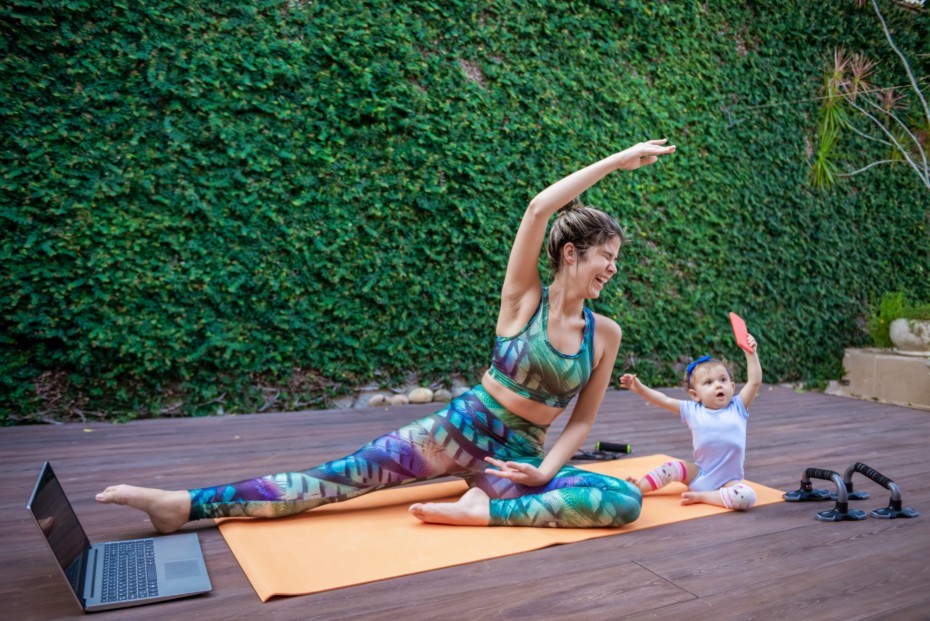
At a time when many of us are spending more time than ever in front of our computer as we work from home, staying active is becoming a challenge. Aaron Fellows looks at the importance of an active lifestyle and offers tips on how to achieve our fitness goals during the COVID-19 pandemic. Read the Q&A.
Fellows is the Project Coordinator and Kinesiology Clinic Supervisor in the Department of Kinesiology and Physical Education.
Now that I am working from home, I walk from my kitchen to my desk and don’t move for hours. What kind of impact can a sedentary lifestyle have on my health?
There has been a lot of research in this area recently, and the results are quite comprehensive. According to the World Health Organization, physical inactivity ranks fourth among the five leading causes of global mortality, along with high blood pressure, tobacco use, high blood glucose and being overweight.
The other major health concern is that being physically inactive is one of the leading causes of lifestyle diseases. Lifestyle diseases are conditions that are mainly caused by leading a poor lifestyle such as type 2 diabetes, cardiovascular disease, chronic respiratory disease and cancer. These four diseases all share physical inactivity as one of the major leading causes. That’s the bad news, the good news is we can change this risk factor by being more active.
What are the benefits of adding physical activities to our daily schedule?
In addition to reducing your chances of getting the above conditions, adding more physical activity to your daily schedule can provide you with many benefits, including:
- Increased energy: Many people think that if you exercise you will be more tired, often from my experience, it will in fact give you the opposite effect. You will feel more energized, most likely be more productive and just feel better in general.
- Reduced stress and improved mental health: Exercise is not only good for physical health but it is great for mental health. Physical activity reduces the levels of stress hormones in the body. It also promotes the production of endorphins which are chemicals located in the brain and can help with reducing pain and improving mood.
- Improved health and daily functions: In addition to everything mentioned so far, exercise can also help to maintain or improve cardiovascular health and fitness as well as improve muscular strength and endurance and flexibility. This is important when we think of daily functions such as being able to walk further for longer, be able to lift and carry heavier things, play with our kids, and carry those extra grocery bags.
- Improved sport performance: Whether it be running your first 5km race, completing your first half marathon or just generally improving in your chosen sport, having increased cardiovascular fitness, flexibility and improved muscular strength and endurance will play a large role in enhancing your performance.
How much physical activity should we aim to do each day?
The Canadian physical activity guidelines state for adults 18 and above that we should be aiming to accumulate at least 150 minutes of moderate-vigorous intensity aerobic activity per week in bouts of 10 minutes or more. It is also suggested to incorporate muscle and bone strengthening activities (lifting weights or body weight exercise) at least two times per week.
So, if we break that down per day we could say at minimum trying to do 30 mins per day at least five days per week would get us to 150 minutes. This is also flexible (it could be 60 minutes one day, and 30 minutes the next). The key is getting to that number of 150 minutes by the end of the week.
Is it better to take small exercise breaks throughout the day or have one longer period of activity?
This ties in with the above question. You could say that doing a one-hour exercise session allows better flow and allows you to get more benefits from your workout. However, for a lot of people doing one hour at a time may not be possible.
If you for do three 20-minute exercise sessions throughout the day, you can still experience the benefits of exercise.
This question I think ultimately comes down to your personal goals and objectives as well as what is realistic for your situation in terms of spare time throughout the day. Some people are not motivated to do one hour of exercise at a time so doing smaller bouts may seem more achievable. The answer is whichever method helps you the most in achieving the 150 minutes of accumulated exercise per week.
What sort of activities should we be doing?
During this time of COVID-19 I think it is really important to work on all aspects of our health and fitness such as, cardiovascular fitness, muscular strength and endurance and flexibility.
- Flexibility: Flexibility and stretching are key and so are activities like yoga and tai chi. Firstly, you don’t need much or any equipment and since for most of us we are probably more sedentary these days so stiff and tight muscles especially in the back, neck and shoulders tend to be common consequences. Yoga and tai chi often focus on breathing as well which helps greatly when stress levels are high.
- Cardiovascular fitness: If you can go outside then activities such as brisk walking, jogging and cycling are all great options. If you are confined to indoors then jumping jacks, burpees, jogging on the spot shadow boxing (air punches with light weights in your hands) are all options. Just be mindful if you are new to exercise or have knee problems about doing high impact exercises such as jumping and running. These types of activities can place more stress on the knees and hips.
- Muscular strength and endurance: For muscle strengthening activities focus on body weight exercises such as squats, lunges, planks, push-ups and triceps dips. Feel free to also get creative and find ways to add weights. For example, cans of beans, or olive oil or bottles of water can replace dumbells, putting books in backpacks and then wearing the backpack on your back can be a good way to add weight to your squats and lunges.
What if I don’t have a home gym? How restricted are my options?
There are many options if you do not have any equipment at home. As mentioned above, using everyday pantry items or books can be an easy way to incorporate weight. If you can’t use these there are many body weight exercises (exercises we do where our body weight provides the resistance, such as pushups) can be performed to help us achieve our goals. There are many great resources online and YouTube videos with trainers doing sessions with no equipment.
How important is walking for physical fitness? How much walking must I do to get benefits?
Walking is great for physical and mental health. The great thing about walking is that everyone can do it. To get the benefits keep in mind that number of 150 minutes per week of accumulated time. I think the key is the speed of walking. If we aim to walk at a brisk speed at minimum (or at a speed where we feel our breathing rate increase, or our heart pump a little bit faster) then you are on the right track.
Is it OK to be doing outdoor activities during the pandemic?
We should always be following the directives of the government and health officials. However, when out taking your walk there is no reason why you can’t find some space and do some simple exercises such as squats, lunges, a plank in the grass. Just make sure to wear a mask. Cycling is OK also, and a great way to keep moving.
With gyms closed, many people have lost their motivation to train. What can they do to help find that drive again?
I think most of us like a routine. One of the biggest challenges for people I work with is making exercise a part of their daily or weekly routine. Personally, I find that choosing a time each day or throughout the week helps block out time for me.
To help with motivation I find exercise videos that I can follow. There are many trainers and kinesiologists who can be hired for sessions to help with motivation. There are also still many exercise group classes that gyms are offering that can help with motivation.
Another option may be to work out with a friend where you are online at the same time. Even if you are not motivated one day, knowing that someone else is waiting for you to join them can provide good motivation.
Words of advice for people who aren’t very physically active but would like to start now?
Start slow and don’t try to do too much at once. Sometimes we get very motivated to exercise – which is great. But then going out for that first session and doing a two-hour workout may only make you very sore and increase your chances of injury. Your motivation may decrease if you can’t walk for three days after.

The key to exercise is consistency. You are better off doing three days of 30-45 minutes of exercise than one day of two-hours. Take the first one or two sessions to find how much is right for you, and slowly build up from there.
Experiencing soreness is normal, especially in the first few weeks. Our bodies take a few weeks to get used to physical activity, particularly when it has been a long time since we were last active. A good way to combat this is to ensure you give yourself one day of rest in between exercise sessions.
If you have any injuries or bad joints avoid high impact activities. High impact activities may include jumping, deep squatting past 90 degrees, and fast running. For those people low impact activities such as cycling and brisk walking may be better options. If an exercise hurts (gives you a pain that you think is not normal) stop the exercise and find something else.
One last note, don’t get down if you don’t achieve your goals in six weeks. Often changes in the body take time. I usually tell people that it takes at least 6-8 weeks before seeing some small changes. Keep in mind that after 6-8 weeks of training you will have built up a good amount of strength and endurance and so it’s at this point you may be able to start increasing the intensity of your sessions. So, weeks 8-12 are very important. Just be patient.

Can you have a yoga class on line very day for McGill students?
Great tips! Working out from home, even if it is for 30 minutes a day is keeping me mentally and physically fit these days!
The decision to admit pediatric patient with mild-to-moderate COVID-19 should be made on case-by-case basis